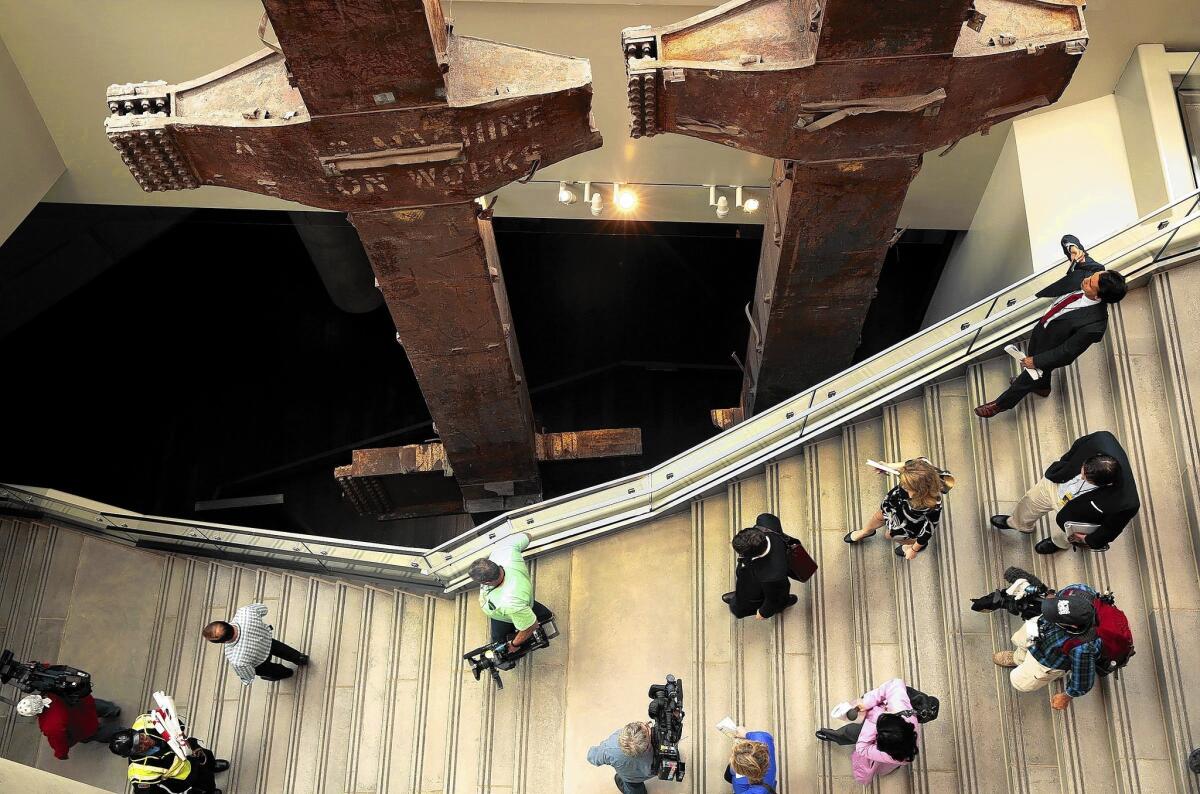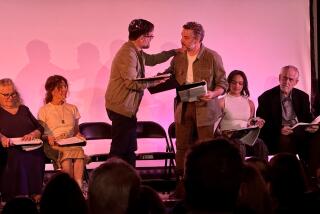9/11 Memorial Museum works through nation’s pain to honor victims

- Share via
reporting from NEW YORK — “Listen, I’m on an airplane that’s been hijacked.”
The voice is calm, as if from a man running late for dinner, not from someone about to die.
The man speaking, Brian D. Sweeney, is gone, but his last message to his wife can be heard by picking up a handset in the National September 11 Memorial & Museum, which opens next week after years of debate over how to remember an event that spawned heartbreak, heroism, wars, political upheaval and finally the revival of ground zero.
On Thursday, President Obama will speak at a dedication ceremony for the museum, which opens to the public May 21. On Wednesday, museum officials opened the doors to the media and to some of the officials, architects, planners and others, including 9/11 family members, who helped oversee completion of the 110,000-square-foot exhibition space at the site of the fallen World Trade Center towers.
“It was never easy, but it was essential,” said former Mayor Michael R. Bloomberg, chairman of the nonprofit foundation that manages the museum. Bloomberg and Joe Daniels, the foundation’s president and chief executive, said that despite the tragic overtones of items on display — the battered firetrucks, the shoes of office workers who died, the audio recordings of victims’ last voice mails — the goal was to honor the nearly 3,000 people who got up that morning, left their homes and never returned.
“In a very real sense, they were who we are,” Daniels said of the dead.
The museum also provides a history lesson about Osama bin Laden and Al Qaeda, and about the hijackers who seized the jets on Sept. 11, 2001, and the attackers who bombed the World Trade Center in February 1993. Some Muslim groups objected to a short film, “The Rise of Al Qaeda,” which is part of the exhibit, saying it could lead viewers to blame Islam for the attacks. Some family members objected to the museum’s $24 admission fee, saying it would turn a site of tragedy and reflection into a moneymaking tourist stop.
But the film remains, and officials say that in the absence of federal funds to cover the museum’s $60-million annual budget, officials have to charge admission. Victims’ families, and police, firefighters and others who responded to the attack, will not be charged.
Most of the museum is 70 feet below ground, beneath what used to be the two World Trade Center towers and what is now the 9/11 Memorial, an outdoor plaza that opened in 2011.
The first thing visitors notice as they enter the bright, glassed-in lobby are two, five-story high steel columns resembling three-pronged forks, which were part of the North Tower’s exterior support structure. The word “Save” appears in large letters on one column, painted by recovery workers who guessed that the pieces should be preserved.
From the lobby, the museum begins a gradual descent into the dim, cavernous exhibit space, where a progression of displays eases visitors into the heart of the tragedy.
It starts with a montage of audio recordings of people recalling where they first heard that America was under attack.
“I was in Times Square,” one says. “I was in Honolulu,” says another.
The voices echo through the chamber, gently overlapping, as photographs of stunned onlookers flash on mesh-covered panels.
Everywhere, there are remnants of the twin towers. There is a jagged chunk of steel that was on the exterior of one tower, between floors 93 and 99, at the point where American Airlines Flight 11 pierced the building. There is a portion of a ghostly white stairway, which proved an escape route for hundreds of survivors.
Broken cables protrude from a massive elevator motor retrieved from a tower. A nearly 20-foot-long piece of the north tower’s TV antenna is but a fraction of the original 360-foot structure.
The pieces are breathtaking for their size and for the stories behind them, but it is the smaller items that are the most haunting, for they underscore how normally the day began, and how quickly everyday people were caught up in tragedy.
“84th floor west office — 12 people trapped,” reads a hand-scrawled note on a crumpled piece of paper, found on the ground after the South Tower fell. A quarter-sized splotch of blood on the paper was traced to Randolph Scott, who died in the attacks.
The white dust that coated lower Manhattan after the buildings fell clings to many of the hermetically sealed items, including the high-heeled black shoes, the sensible beige pumps and the men’s leather lace-up shoes on display.
The voices of victims, and of their worried friends and families, can be heard through the handsets.
One of those voices belongs to Sweeney, who was on United Airlines Flight 175 as it flew toward the South Tower.
“It’s not looking good,” Sweeney told his wife, Julie Sweeney Roth, in the 23-second message on their home answering machine. “I just want you to know I absolutely love you, I just want you to do good, go have good times, same to my parents and everybody.”
Then Sweeney, trying to inject some optimism into the call, said, “Bye,” and added: “I hope I call you.”
More to Read
Sign up for Essential California
The most important California stories and recommendations in your inbox every morning.
You may occasionally receive promotional content from the Los Angeles Times.











